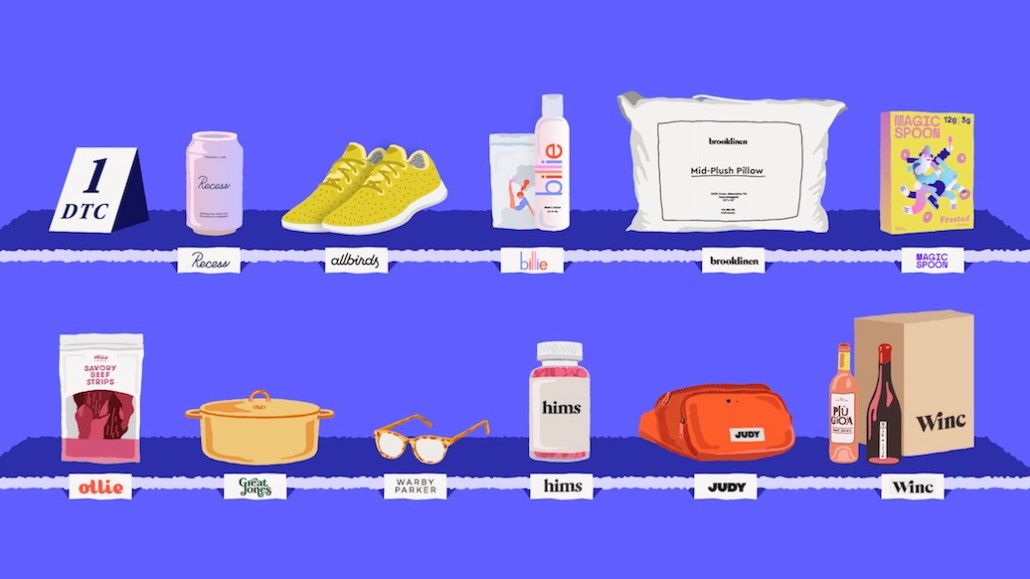As headwinds emerge, DTC brands bet on early growth to carry them through the rest of the year

In March, Sarah Moret, CEO of natural deodorant brand Curie, had to throw her plans for the year out the window.
Her two-year-old company had already developed a formula for hand sanitizer that the company was working to release in October, but decided to move up the production date in response to health concerns. Curie was also on the cusp of announcing that it had struck some deals with fitness studios to carry its deodorant. As it became clear that fitness studios would remain closed for longer than a couple of months, Moret was able to strike a partnership with Anthropologie, who started carrying Curie’s products in stores and on its website last week.
The scrambling worked: From March to June, Moret said that Curie averaged month-over-month revenue growth averaged 110%.
Curie’s not the only DTC brand to have reported astronomical sales growth during the coronavirus pandemic. Even the most bullish consumer investors I’ve spoken with have been surprised at just how much sales growth many of their portfolio companies have seen during the pandemic, unless they are in a category where appetite for those products has all but vanished, like formalwear or travel accessories.
The big question though, is just how long this astronomical growth will last. As coronavirus cases have started rising again, forcing some states like California and Texas to re-close some businesses — meanwhile Congress squabbles over how much to extend enhanced unemployment benefits — I wondered whether or not this may hamper some of the e-commerce growth that DTC brands have experienced.
It’s a mixed bag, but so far, the five DTC startups I spoke with said they aren’t seeing many troubling signs of headwinds. And, they’re confident that cash preservation steps they took at the beginning of the pandemic, combined with their customer acquisition costs having decreased during the pandemic, will help carry them through the rest of the year.
Two startups — Lalo, which sells strollers and kid’s furniture, and paint brand Clare — said that their July revenue is on track to surpass June’s. “We are in a category where there is always demand, and in paint, there is generally a spike in the spring and summer months,” said Clare CEO Nicole Gibbons.
Moret said that while Curie saw a single-digit decline in sales the first two weeks of July compared to the same period in June, sales have since picked up again. Athleticwear brand Vuori, whose e-commerce sales have grown 329% between March and July, said that it’s still seeing increased demand in July, but is also having trouble keeping items in stock, which CEO Joe Kudla said may hamper sales growth a bit.
“It tells me that this broader shift to e-commerce — it’s feeling like it’s here to stay,” Kudla said. He said that Vuori has acquired 220% more customers in the second quarter of this year compared to the first quarter, so retention will be a key focus for the company for the rest of the year in order to maintain momentum.
Back to basics
Caraa, which sells luxury sports bags, has been the hardest hit among the DTC brands I spoke with, because its bags are designed for many activities that aren’t feasible right now, like traveling and going to the gym. CEO Aaron Luo said that Caraa’s sales dipped in April and May, and then started rebounding around the beginning of July.
He said that some activity he’s seen in recent weeks has made him more optimistic for the rest of the year. Namely, one of its most expensive collections is now one of its best selling. What’s more, customers are spending more time on Caraa’s site before buying than they usually do. “It almost felt like she has been holding back on purchases,” he said.
Still, in preparation of a tough year, Luo got to work in the spring negotiating with as many of Caraa’s vendors as possible. He said that those steps, combined with the fact that Caraa is a vertically-integrated company, and thus can more tightly control its inventory, makes him confident that the business will remain “in a healthy position” at the end of the year.
For the early stage DTC startups who are seeing higher-than-expected sales growth, they are not resting on their laurels either. Gibbons said that Clare has had to put a few initiatives on the back burner during the pandemic, and has instead spent the past few months focusing on making improvements to its website like adding a loyalty program, making it easier to “bundle” products, and improve analytics reporting. Moret said that while Curie’s sales have been up, she’s spent more on inventory over the past few months. Curie’s products went out-of-stock a few times last year, which she doesn’t want to repeat this year because “it was a lesson that you can’t lose momentum.”
While Moret is thankful for the sales growth her company has experienced over the past few months, she said that she’s not betting on it to last forever.
“[Sales] are not always up and to the right, ” she said. ‘There is a lot that is in flux and is changing, and as entrepreneur you have to know those downs are going to be followed by ups.”
More in Marketing

Best Buy, Lowe’s chief marketing officers explain why they launched new influencer programs
CMOs launched these new programs in response to the growing importance of influencers in recommending products.

Agencies create specialist units to help marketers’ solve for AI search gatekeepers
Wpromote, Kepler and Jellyfish practices aim to illuminate impact of black box LLMs’ understanding of brands search and social efforts.

What AI startup Cluely gets — and ad tech forgets — about attention
Cluely launched a narrative before it launched a tool. And somehow, it’s working.








